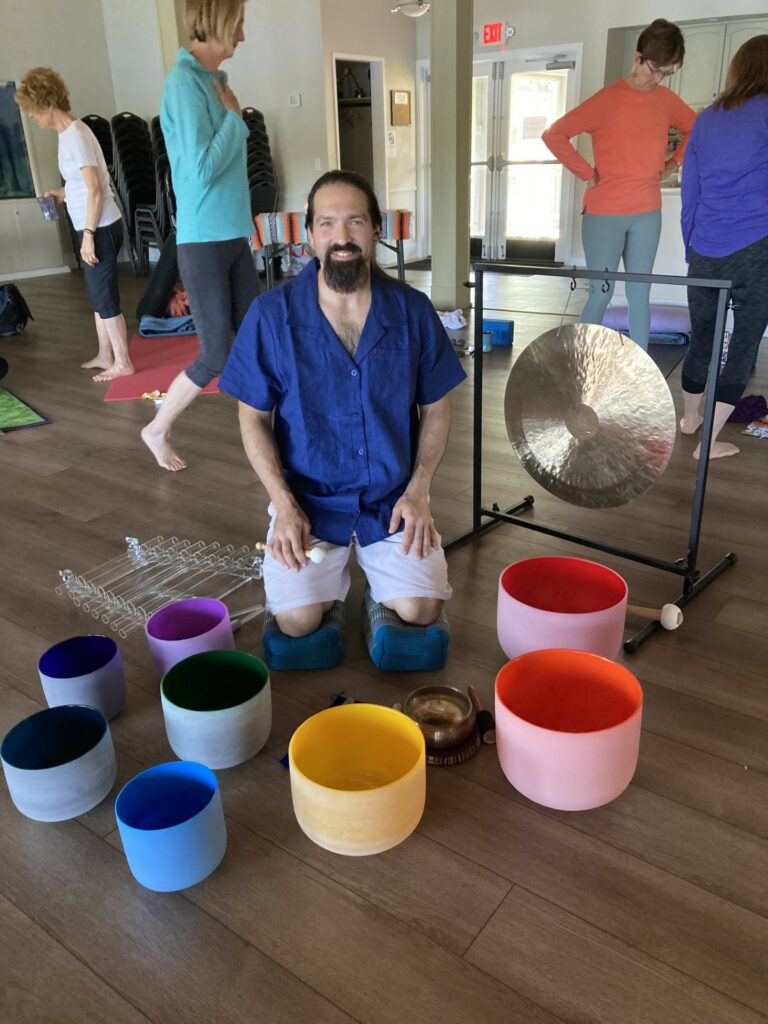Benefits of the ancient practice, and how to try one yourself.
By Anna Davies Published: Oct 25, 2021
More relaxed. Less stressed. Connected to your creativity and ready to take on whatever the day may bring. Sounds like an ideal state, right? This is what people take sound baths can experience—a more calm state of mind is one of the primary benefits.
An ancient meditative practice with roots from two thousand years ago in Tibet, sound baths have gained fairly recent popularity in the United States. It’s not uncommon that a sound bath experience be offered by yoga studios, meditation spaces, wellness retreats and other experiences that lean into mind-body practices.
“A sound bath is where you immerse yourself in sound frequency,” explains Elizabeth Trattner, an acupuncturist nationally board certified by the National Certification Commission for Acupuncture and Oriental Medicine. “Sound all around you creates a ‘bath’ of visceral sound where you can feel the frequency of sound in the deepest parts of your body. A sound bath creates a meditative state where the brain emits healing brainwaves.”
A sound bath can be meditative and relaxing, and many times, the benefits depend on how you go into the session.
Unlike yoga, there are no physical fitness or flexibility requirements, and it’s something that can be equally enjoyed by new and experienced practitioners alike. Here you can find out what a sound bath is (hint: No soap required), what it does, the purported benefits, and how it may help you relax and reset.
What exactly is a sound bath?
To understand what a sound bath is, it’s important to address what a sound bath is not: A sound bath does not involve water or a bath tub, and no nudity required. Instead, a sound bath “surrounds” your body with different sounds, resulting in a shifted mental state that many proponents feel can be relaxing in a way that’s similar to meditation.
In a traditional sound bath experience, different Tibetan singing bowls — a type of instrument that emits different sounds based on the vibrations made by a mallet — are used. There could be as many as 40 different Tibetan singing bowls used within the sound bath, and the sound isn’t necessarily the “music” you’re used to hearing. Instead, different tones and frequencies can help lead you to a meditative-like state.
A sound bath does not necessarily need to be a group experience. A sound bath can also be done solo, with help from a playlist.
Benefits of a sound bath
Sound baths have multiple benefits. A recent study has found that the sounds that emerge in a sound bath may reduce stress and anxiety.
Trattner recommends setting an intention when you go into a sound bath. This might be to recharge or it may be to get past a certain mental block or issue that’s been bothering you. There are no “rules” to experiencing a sound bath. Some people may close their eyes and lie down, others may sit cross legged, or others may walk around the room.
The sound bath practitioner may share some best practices to ensure that the experience is the best it can be for you and other participants. Sound bath experiences may last between 60 and 90 minutes, but there may also be shorter or longer experiences.
How to experience a sound bath
Many yoga studios and other wellness studios offer sound bath experiences. Speaking with local wellness practitioners — acupuncturists, reiki specialists, yoga teachers — may guide you to a local sound bath experience. You also may be able to set up a private sound bath experience with a practitioner. This may be in-person or remote.
You’ll want to come to your sound bath experience early and wear comfortable clothes. It’s also a good idea to come hydrated, since sound travels better through water, says Trattner (including the water in your body) You may want to eat a light meal, but don’t want to be overly full (which may lead to you falling asleep) and want to steer clear of alcohol prior to the experience.
After the sound bath, you may feel dreamy or relaxed. Take the time you need to “come out” of the sound bath. It can be a good idea to have a sound bath at night and then go to sleep without focusing on screens or devices.
You can also experience a DIY sound bath at home. Some people may like to experiment making sounds with their own singing bowl. Other people may find playlists or videos online. If you’re having a sound bath at home, the same rules apply: Get comfortable, get hydrated, and make sure you have plenty of time (phone off!) to sink into the sounds and vibrations.
You can have a sound bath experience as frequently (or infrequently) as you like. Trying different experiences and practitioners, or experimenting on your own, can help you assess how effective a sound bath is for your mindset.
Experience a Sound Bath at Island Fitness!
- Sound Bath with Alexa Rosenthal and Michael Almodovar on the first Thursday of each month as part of the group fitness schedule. Next Sound Bath 11/2/23 6:45 pm.
- Weekly Evening Mediation with Alexa Rosenthal – Thursdays at 6:45 pm beginning with 11/2 Sound Bath Mediation
To register for any group Fitness class follow this link to our class schedule and register.
Questions? Contact Beth Cook

